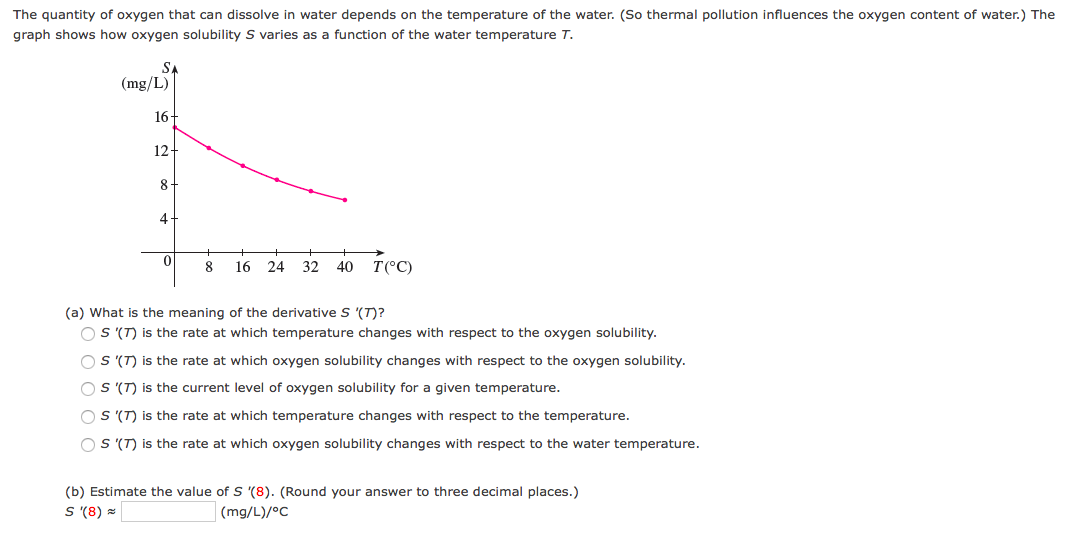The quantity of oxygen that can dissolve in water depends on the temperature of the water. (So thermal pollution influences the oxygen content of water.) The graph shows how oxygen solubility S varies as a function of the water temperature T. SA (mg/L) 16 12- 8. 4 8 16 24 32 40 T(°C) (a) What is the meaning of the derivative s (T)? O S (T) is the rate at which temperature changes with respect to the oxygen solubility. O S (T) is the rate at which oxygen solubility changes with respect to the oxygen solubility. O S (T) is the current level of oxygen solubility for a given temperature. O S (T) is the rate at which temperature changes with respect to the temperature. O S ((T) is the rate at which oxygen solubility changes with respect to the water temperature. (b) Estimate the value of S '(8). (Round your answer to three decimal places.) S (8) = (mg/L)/°C
The quantity of oxygen that can dissolve in water depends on the temperature of the water. (So thermal pollution influences the oxygen content of water.) The graph shows how oxygen solubility S varies as a function of the water temperature T. SA (mg/L) 16 12- 8. 4 8 16 24 32 40 T(°C) (a) What is the meaning of the derivative s (T)? O S (T) is the rate at which temperature changes with respect to the oxygen solubility. O S (T) is the rate at which oxygen solubility changes with respect to the oxygen solubility. O S (T) is the current level of oxygen solubility for a given temperature. O S (T) is the rate at which temperature changes with respect to the temperature. O S ((T) is the rate at which oxygen solubility changes with respect to the water temperature. (b) Estimate the value of S '(8). (Round your answer to three decimal places.) S (8) = (mg/L)/°C
Chapter6: Exponential And Logarithmic Functions
Section6.1: Exponential Functions
Problem 60SE: The formula for the amount A in an investmentaccount with a nominal interest rate r at any timet is...
Related questions
Question

Transcribed Image Text:The quantity of oxygen that can dissolve in water depends on the temperature of the water. (So thermal pollution influences the oxygen content of water.) The
graph shows how oxygen solubility S varies as a function of the water temperature T.
SA
(mg/L)
16
12-
8.
4
8
16 24
32
40 T(°C)
(a) What is the meaning of the derivative S (T)?
O S (T) is the rate at which temperature changes with respect to the oxygen solubility.
O S (T) is the rate at which oxygen solubility changes with respect to the oxygen solubility.
O S (T) is the current level of oxygen solubility for a given temperature.
O S (T) is the rate at which temperature changes with respect to the temperature.
O S ((T) is the rate at which oxygen solubility changes with respect to the water temperature.
(b) Estimate the value of S '(8). (Round your answer to three decimal places.)
S (8) =
(mg/L)/°C
Expert Solution
This question has been solved!
Explore an expertly crafted, step-by-step solution for a thorough understanding of key concepts.
This is a popular solution!
Trending now
This is a popular solution!
Step by step
Solved in 2 steps with 1 images

Recommended textbooks for you


Linear Algebra: A Modern Introduction
Algebra
ISBN:
9781285463247
Author:
David Poole
Publisher:
Cengage Learning

Functions and Change: A Modeling Approach to Coll…
Algebra
ISBN:
9781337111348
Author:
Bruce Crauder, Benny Evans, Alan Noell
Publisher:
Cengage Learning


Linear Algebra: A Modern Introduction
Algebra
ISBN:
9781285463247
Author:
David Poole
Publisher:
Cengage Learning

Functions and Change: A Modeling Approach to Coll…
Algebra
ISBN:
9781337111348
Author:
Bruce Crauder, Benny Evans, Alan Noell
Publisher:
Cengage Learning

Glencoe Algebra 1, Student Edition, 9780079039897…
Algebra
ISBN:
9780079039897
Author:
Carter
Publisher:
McGraw Hill

Algebra & Trigonometry with Analytic Geometry
Algebra
ISBN:
9781133382119
Author:
Swokowski
Publisher:
Cengage